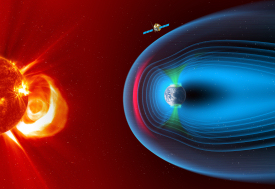Science objectives
SMILE will gather remote-sensing (X-ray) measurements of Earth's magnetospheric cusps, magnetopause, and bow shock, while also providing simultaneous auroral imaging (UV) of Earth, and coordinated in situ measurements (plasma and magnetic). These data will complement and build on the localised data provided by existing ground- and space-based observatories, including ESA's Cluster and Swarm missions, and NASA's Magnetospheric Multiscale Mission (MMS).
SMILE will tackle three key questions that currently remain unresolved:
- What are the fundamental modes of the dayside solar wind/magnetosphere interaction?
The manner in which energy and plasma enters the magnetosphere is crucial to understanding and predicting how the magnetosphere will respond. SMILE will explore the phenomenon of magnetopause reconnection, and seek to determine when and where transient and steady reconnection states dominate.
- What defines the substorm cycle?
The substorm, a disturbance in Earth's magnetosphere that causes energetic particles to enter the ionosphere from higher latitudes, is thought to control how energy and plasma circulate within Earth's magnetosphere. SMILE aims to define this cycle, including timing and amplitudes.
- How do CME-driven storms arise, and what is their relationship to substorms?
Geomagnetic storms driven by coronal mass ejections (CME) represent a severe space weather threat. SMILE will study how and why CME-driven storms develop, and determine whether or not they are always separate phenomena, or can be considered as sequences of substorms.
 |
| Science with SMILE. Credit: ESA/ATG medialab |
These three questions remain open due to a lack of available observations – we do not know enough about the location and shape of Earth's outer magnetospheric boundaries, nor about how the solar wind behaves at these boundaries. This is partly due to the financial and technical constraints on developing multi-satellite missions; it is costly to launch a fleet of spacecraft that would be needed to obtain a global perspective of the Earth's environment.
However, recent discoveries have shown that Earth's outer magnetosphere can be imaged another way, thanks to the process of solar wind charge exchange (SWCX). This process can be detected when solar wind ions interact with neutral atoms in Earth's exosphere (the uppermost layer of the atmosphere), and forms characteristic soft X-ray emission with intensities that peak in the cusps and magnetosheath. In this way, it is possible to image the bow shock, magnetopause, and cusps in X-ray wavelengths. The technique of observing SWCX emission in the vicinity of Earth has been successfully demonstrated by ESA's XMM-Newton in recent years.
SMILE will gather the new observations needed to apply this technique to Earth's magnetic environment.